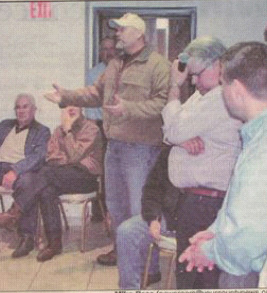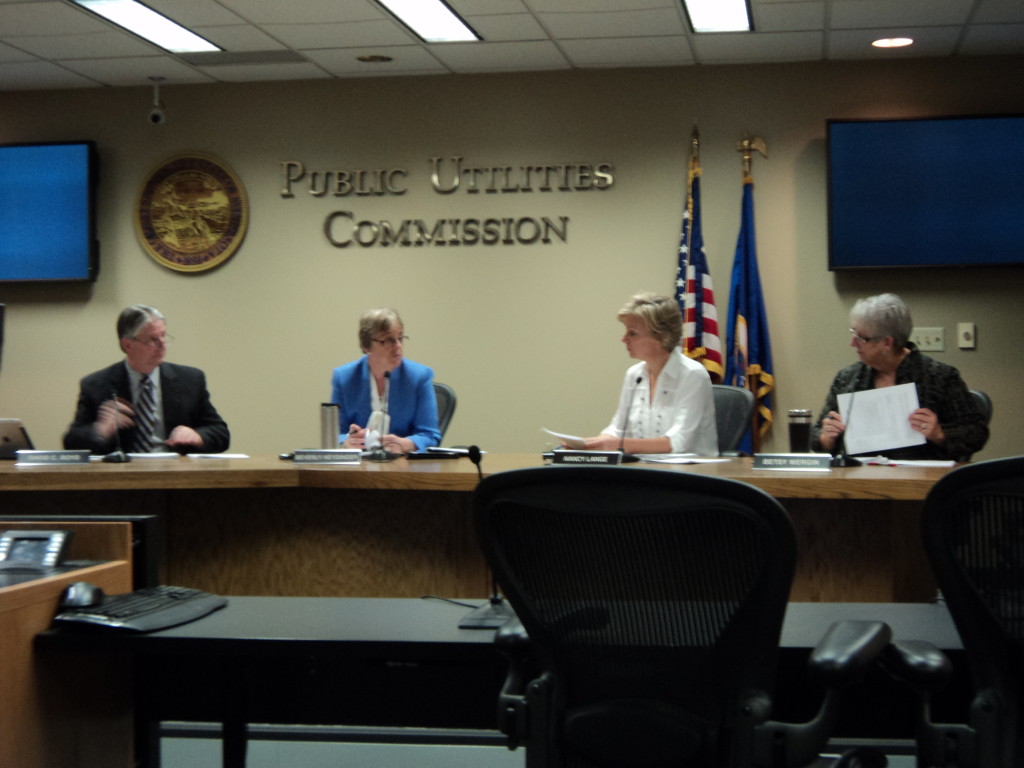After 5 (#&%(#)* years — Goodhue Wind is DEAD!
October 10th, 2013
What a day at the Minnesota Public Utilities Commission:
This project, applied for back in 2008 as “Goodhue Wind” and then in January 2010 becoming AWA Goodhue, and then ??? more recently becoming “New Era Wnd,” has been a headache for the state since the original application. For those in and near the footprint, it’s been much more than a headache. Now, after over 5 years of weighing in, participating, dodging helicopters and gathering frightened cattle, digging through deeds and filings at the County Recorder’s office, scouring the countryside for eagle nests that developers don’t want found, compiling piles and piles of information and testimony about impacts of low frequency sound, wading through misrepresentations, misstatements and mischaracterizations and discovering the truth, taking every possible avenue to be heard and finding a few more for good measure, after five long years we can finally say, “YES!!!” this project is over, it is done, DEAD!
The Goodhue Wind Certificate of Need and Siting Permit have been REVOKED. The Power Purchase Agreements with Xcel Energy have been terminated.
Five long years, what a headache…

Five years — what took so long?
Looking at the big picture, this is an example of systemic problems within the state, at the Public Utilities Commission, at the Dept. of Commerce, and at the legislature.
I also ask, what is it with these projects in Goodhue County? I’ve been involved in three of them, three projects not built, ranging from NSP’s nuclear waste “in Goodhue County” in Florence Township; to the Kenyon Wind project proposed by John Daniels, husband of Windustry’s Lisa Daniels and which, as the first C-BED project in the state, proposed to put a substation and turbine on former House Speaker Steve Sviggum’s land; and this “Goodhue Wind” project (note that we’re not counting the quickly dropped CapX 2020 initial talk of coming down the west side of the Mississippi over “Site P” in Florence Township, and the much longer CapX 2020 proposal and ultimately permitted transmission line on the west end of the county, that is a whole ‘nother story, to be found at www.nocapx2020.info!). NONE of these three projects were built, and ALL took five years to get from proposal to rejection. WHY SO LONG?
I see this as a litany of systemic problems.
SYSTEMIC PROBLEM #1 – INADEQUATE ENVIRONMENTAL REVIEW
It’s pretty much a no-brainer, but once more with feeling… environmental review for wind projects is inadequate because the siting law exempts wind projects from environmental review!!! This is not compliant with the Minnesota Environmental Policy Act. And under the Certificate of Need rules, all that’s necessary is an “Environmental Report,” and not an Environmental Impact Statement. This “Environmental Report” though, to be clear, is NOT statutory, it is the work of the agency in rulemaking, perfectly legal for the agency to write its own rules, BUT it’s time they were challenged on the result, the failure of any agency to require an environmental impact statement on a project with such significant impacts. We’re in rulemaking now on Certificate of Need, and it’s time to correct that change made about a decade ago.
Another aspect to this is that Bill Grant, formerly Izaak Walton League, is now in charge of utility infrastructure siting at the Dept. of Commerce. Bill Grant is one who helped usher through the legislation exempting wind projects from environmental review!!! He’s got to go and we’ve got to undo the damage he’s brought to the state of Minnesota.
The state law requires:
This review of impacts, including economic, employment, and sociological effects must be addressed. We need to look at the adverse impacts, not ignore them, and we must not inflict the impacts on a community while castigating those who struggle to make the impacts known. And FYI, an “Environmental Report” is not an “Environmental Impact Statement.”
SYSTEMIC PROBLEM #2 – REGULATORS THAT WON’T REGULATE
This project dragged on and on and on and on and on and on, because no one wanted to make a decision on this project. Evidence piled up, the developer wouldn’t produce requested information… How much of a demonstration of inability to put together a project is necessary before action is taken? How much is necessary before it’s apparent that the project shouldn’t have a permit in the first place? How much misrepresentation before the state stands up and says NO! The Public Utilities Commission must be willing to look at the economics and the structure of a proposed project — THEY’RE the regulator. Take a close look at projects, and sooner rather than later!
SYSTEMIC PROBLEM #3 – APPLICANTS ARE RUNNING ROUGHSHOD OVER PEOPLE
Projects run roughshod over people in the area. In this case, standing up to the Goodhue Wind Project took five years of commitment, as significant cost to those who participated. It was the people who initially raised the issues that ultimately killed the Goodhue Wind Project, including C-BED status, eagles, siting, multiple misrepresentations on the part of the Applicants. But this isn’t their job, it’s the job of the regulators, meaning it is the job of the Dept. of Commerce and the Public Utilities Commission to investigate, to verify information, to assure that the applicant produces the information necessary and that its representations are TRUE!
When I work with clients on a project like this, I urge them to develop a big picture approach, and to work within the framework provided. It’s arcane, it’s a royal pain, but this is what we’ve got. Unfortunately, this is not an example where “the system worked,” and instead, it is yet another example that it did not work. The Goodhue Wind Project fell apart of its own deficiencies. YEAAAAAAAAA! But don’t be fooled. The regulatory system in Minnesota is NOT working. Don’t be fooled for one minute!
The good news of this is that Peter Mastic can close his “office” and go back to Nevada:


Leave a Reply